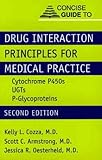September 7, 2008
Concise Guide to Drug Interaction Principles for Medical Practice: Cytochrome P450s, Ugts, P-Glycoproteins (Concise Guides)
By admin
 This Concise Guide is designed to be a practical pocket guide – a reference at the bedside, on rounds, or in the office. This text is divided into several sections: Part I: Introduction to Basic Pharmacology…Part II: P450 Enzymes contains pertinent tables, short reviews, and carefully chosen clinical and research illustrations for each P450 enyzyme…Part III: Drug Interactions by Medical Specialty…Part IV: Practical Matters includes chapters with prescribing guidelines, legal issues, and how to review the literature. Includes a pull-outpocket book of tables.
This Concise Guide is designed to be a practical pocket guide – a reference at the bedside, on rounds, or in the office. This text is divided into several sections: Part I: Introduction to Basic Pharmacology…Part II: P450 Enzymes contains pertinent tables, short reviews, and carefully chosen clinical and research illustrations for each P450 enyzyme…Part III: Drug Interactions by Medical Specialty…Part IV: Practical Matters includes chapters with prescribing guidelines, legal issues, and how to review the literature. Includes a pull-outpocket book of tables.
Customer Review: Hard to believe there are no reviews
I wrote a review for the first edition of this book and thought it was excellent. This edition is even better and as far as I can tell is state of the art even today in researching drug interactions.
The authors provide excellent summaries of drug metabolism in general and specific chapters on cytochromes, phase II metabolism, and P-glycoproteins. The chapters are logically organized and contain many case examples. As an example the cytochrome chapters describe the function, localization, inhibitors and inducers of each enzyme.
Rather than detail the specifics – I can tell you how a clinician treating complex problems might use this book. Medical care has become increasingly complex. It is common to treat people who are taking various combinations of maintenance medications like antihypertensives and cholesterol lowering drugs. Those drugs may be combined with medications to treat diabetes or other chronic medical disorders. The introduction of one or more psychiatric medications can lead to problems at the pharmacokinetic level.
A rapid check using computerized drug interaction programs or lists for specific conditions like prolonged QT syndrome usually yields rare interactions based on case reports in the literature. Reading the specific case reports or program results often gives conflicting results and no theoretical basis. This guide allows the reader to look up specific drugs across chapters and read relevant case illustrations. Chapters also include well organized tables showing specific compounds from the drug classes under discussion with the metabolizing sites and inhibitors. These tables are footnoted with whether the inhibitory effects are mild, moderate or potent.
Using the drug metoprolol as an example – the index shows four pages referenced with three of those pages containing the drug in tables. The pages describe that it is hepatically metabolized by 2D6 and 3A4. The authors provide an analysis of pharmacokinetic drug interactions that illustrate what can happen if the enzymes metabolizing metoprolol are affected by other agents.
The title of this book is somewhat of a misnomer. The authors have done an excellent job of balancing the theoretical and practical aspects of drug interaction in a book that is clinically useful. Any physician prescribing multiple medications or single medication to a patient who is already taking several will find this book extremely useful. The level of scholarship in this book is very high and it has a unique niche in the drug interaction literature. If there is a better book out there on drug interactions – I haven’t found it. If you have – send the reference to me and I will review it and compare it to this book.
George Dawson, MD
Topics: Medical Practice Books | Comments Off on Concise Guide to Drug Interaction Principles for Medical Practice: Cytochrome P450s, Ugts, P-Glycoproteins (Concise Guides)
Comments are closed.
« Medical-Surgical Nursing: Concepts and Practice | Home | Paramedic Care: Principles & Practice, Volume 3, Medical Emergencies (3rd Edition) (Paramedic Care, Volume 3) »
